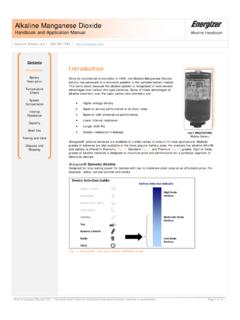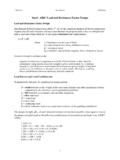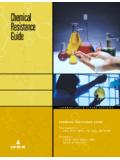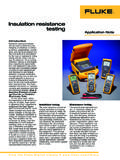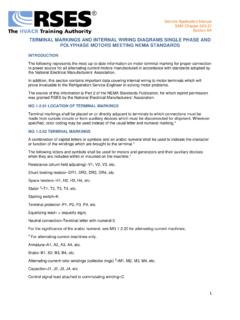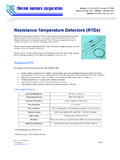Transcription of Simulated Hail Damage and Impact Resistance
1 Page 1 Simulated hail Damage and Impact Resistance Test ProceduresFor Roof Coverings and MembranesBy Vickie Crenshaw and Jim D. Koontz, ,Article based on presentation at Roofing Industry Committee On Weather Issues Meeting, Dallas, TexasOctober 27, 2000As a result of hail Damage to roof coverings and membranes, insurance companies and property ownersspend millions of replacement dollars annually. Over the years, several organizations have attempted toclassify the Impact or hail Resistance of roofing systems. The intent in all cases was to provide somemethod of testing to quantify the relative hail Resistance of roofing systems. Who could have imagined theresulting controversy surrounding finding a test method that would be satisfactory for all systems and meetthe industry s needs?
2 Keywords: Impact energy, Impact Resistance , hailresistance, kinetic energy, velocity, mass, steel, ice, plastic,roof related building code issues traditionally focusedon fire Resistance and structural loading of snow, wind, anddrainage. As building codes evolved, numerous otherconstruction issues came to the forefront including itemssuch as ADA compliance. Historically, neither Impact norhail Resistance were of significant , four major codes include provisions requiringroofing systems to meet minimum Impact resistancerequirements. Specifically, these codes include the BOCAN ational Building Code (BOCA)1; the InternationalBuilding Code (IBC)2; the Standard Building Code(SBCCI)3; and the South Florida Building Code (SFBC) assumes the intent of the code is for a building to beconstructed with a roof covering or membrane offeringsome minimal level of Resistance to Impact or OrganizationsTechnical organizations that have been involved withimpact or hail testing procedures include:American Society for Testing and Materials (ASTM)Canadian General Standards Board (CGSB)European General Agreement Board (EGAB)Factory Mutual Research Corporation (FMRC)National Institute of Science and Technology (NIST)Underwriters Laboratories (UL)The Impact methods developed by these organizationsutilize projectiles made of steel, plastic or ice.
3 In the caseof steel projectiles, darts or spheres of various impactingdiameters are dropped from predetermined heights toproduce an Impact with the same kinetic energy possessedby the same diameter European plastic sphere5 and National Bureau ofStandards NBS/NIST ice sphere projectiles6 arepneumatically propelled. The projectile produces a kineticenergy equal to that of free falling of the problem lies in defining the terms "impactresistant" and " hail resistant". A secondary issue involvesdiscerning whether the two terms are fullyinterchangeable. Additional challenges involve testing ofvarious roofing products and determining whetherimpacting a roof system with a steel or plastic projectileproduces Damage that is comparable to , many of the test methods focus only on newor newly installed material tested only at roomtemperature.
4 The effect of lower surface temperature oftenencountered during actual hailstorms and the effect ofaging are not considered in most test methods. In fact,Koontz reported in 1991 that surface temperature at thepoint of Impact could be a factor in hail WilliamCullen subsequently stated in 1992 "the results of testingnew materials may not be valid since the hail impactresistance of many roofing materials changes uponexposure to weather." 8 Impact and hail Resistance Test ProceduresDepending on the test method, Simulated hailstones ofsteel, plastic or ice are propelled or dropped onto testtargets with predetermined Impact energies. These valuesare derived from the Impact energy of hailstones graphedby Laurie in 1960.
5 Laurie graphed the relationshipbetween terminal velocity, hail diameter and theapproximate kinetic ( Impact ) energy (Table 1).9 Page 2 DiameterTerminal VelocityApproximateImpact Energyinches cm1 ( )1-1/4 ( )1-1/2 ( )1-3/4 ( )2 ( )2-1/2 ( )2-3/4 ( )3 ( )ft/s mi/hr (m/sec) 73 50 ( ) 82 56 ( ) 90 61 ( ) 97 66 ( )105 72 ( )117 80 ( )124 85 ( )130 88 ( )ft lbs Joules <1 (< ) 4 ( ) 8 ( ) 14 ( ) 22 ( ) 53 ( ) 81 ( )120 ( )Table 1.
6 Terminal velocities and energies of hailstonesStandard Test MethodsThe American Society of Testing and Materials (ASTM)Factory Mutual Research Corporation (FMRC) andUnderwriters Laboratories (UL) each have standards forimpact Resistance or hail D 3746: "Standard Test Method for ImpactResistance of Bituminous RoofingSystems"10FM 4470: "Susceptibility to hail Damage , TestStandard for Class 1 Roof Covers"11UL 2218: " Impact Resistance of Prepared RoofCoverings"12 Additional standards include: CGSB 37-GP-56M CanadianGeneral Standards Board "Standard for Membrane,Modified, Bituminous, Prefabricated and Reinforced forRoofing (Dynamic Impact (Puncturing)) Test"13 and ASTMD 4272 "Standard Test Method for Total Energy Impact ofPlastic Films by Dart Drop".
7 14A closer look into a few of these methods revealssignificant variations, not only in the procedures utilized,but also in the resultant data and subsequent certificationattained. With the ASTM D 3746 method, a steel dartdrops from a predetermined height impacting bituminoustest targets with Impact energy 22-ft. lbs. (30 J). Astandard provision allows the test to be performed at anydesired temperature and on new or insitu recognizes the importance of temperature andaging with this certifies roof coverings for hail Resistance . Thistest method utilizes steel balls dropped onto test targetsfrom various heights. Two FMRC certifications areavailable: Class 1 - SH (Severe hail Resistance ); and Class2 - MH (Moderate hail Resistance ).
8 UL certifies roof coverings or membranes for impactresistance. The method utilizes four sizes of steel ballsdropped at various heights onto a roofing system testtarget. The Impact Resistance is based on four classes withClass 4 the most resistant. Testing is performed on newroof coverings at room notable differences exist between the test methodsutilized by FMRC and UL. For instance, artificialweathering is employed in the FMRC test procedure butnot in the UL. FMRC procedures address new roofcoverings (or membranes on test decks) and similar onesexposed to 1,000 hours of weathering. UL procedures testnew material review of the procedures used by FMRC and ULindicates that UL requires separation of bituminous ormulti-layer samples into individual components todetermine internal Damage from Impact .
9 In some cases, aswith SBS membranes, the membrane may pass the impacttest with slight granule loss. However, separation of thesample may reveal interply mopping asphalts have beenfractured as shown in Figure A. The FMRC proceduredoes not require separation of the sample; instead, visualexamination of the top and bottom of the sample isconsidered A. Fractured Interply Moppings of a SBS Modified Roof SystemIt should be noted that both FMRC and UL test proceduresare performed at room temperature, without taking intoaccount the temperature drop usually experienced during ahail testing inconsistencies between FMRC and UL mayresult in one roofing system passing a hail test, but failingthe Impact test of the other comparison, Table 2 summarizes the respective teststandards, parameter and Impact energies of the ASTM,FMRC and UL ParametersStandardDiameter,in (mm)Masslbs (kg)Distance,ft (mm)Energy,ft.
10 Lbs. (J)ASTM D 37462 (50)( )4 (1355)22 ( )FM Class (45)(.360)17 (5400)14 ( )FM Class I-MH2 (51)(.737)5 (1500)8 ( )UL Class (32).28 (.127)12 (3700) ( )UL Class (38).48 (.218)15 (4600) ( )UL Class (46).79 (.358)17 (5200) ( )UL Class 42 (51) (.521)20 (6100)23 ( )Table 2. Kinetic energies produced by ASTM, FM, and UL standard 3 Ice Sphere MethodAnother test method involves propelling an ice sphere at aroofing target. The NBS Series 23 (Ice Sphere Method) isbased on the early work of Sidney Greenfield. Using icespheres, Greenfield researched the hail Resistance ofvarious roofing materials. Greenfield utilized the terminalvelocities and Impact energies by Laurie (Table 1) in hisresearch and these continue to be the primary values February 2000, FMRC published test standard ClassNumber 4473 "Specification Test Protocol for ImpactResistance Testing of Rigid Roofing Materials byImpacting with Freezer Ice Balls".

